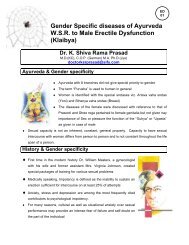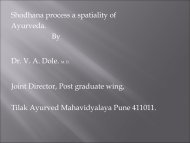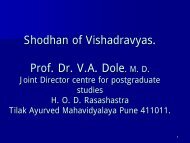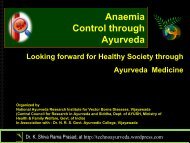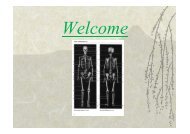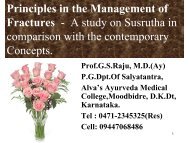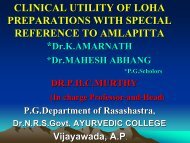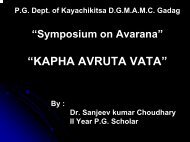Aushadha Sevana (Applied Medicinal Intake) - Techno Ayurveda
Aushadha Sevana (Applied Medicinal Intake) - Techno Ayurveda
Aushadha Sevana (Applied Medicinal Intake) - Techno Ayurveda
You also want an ePaper? Increase the reach of your titles
YUMPU automatically turns print PDFs into web optimized ePapers that Google loves.
<strong>Aushadha</strong> <strong>Sevana</strong><br />
(<strong>Applied</strong> <strong>Medicinal</strong> <strong>Intake</strong>)<br />
Dr. K. Shiva Rama Prasad, at http://technoayurveda.wordpress.com/
<strong>Aushadha</strong> <strong>Sevana</strong> (<strong>Applied</strong> <strong>Medicinal</strong> <strong>Intake</strong>)<br />
Introduction<br />
• Success in Medical practice depends upon, 4<br />
factors viz. Patient, Physician, Assistant &<br />
Medicine<br />
• The <strong>Medicinal</strong> action differ by –<br />
– Selected Medicine<br />
– Route selection<br />
– Type of administration<br />
– Time of administration<br />
• Present context is with the time of drug<br />
administration in <strong>Medicinal</strong> <strong>Intake</strong><br />
• The intake could be of many ways – ingestion,<br />
inhalation, consumption, uptake, inletting, etc.<br />
Dr. K. Shiva Rama Prasad, at http://technoayurveda.wordpress.com/
<strong>Aushadha</strong> <strong>Sevana</strong> (<strong>Applied</strong> <strong>Medicinal</strong> <strong>Intake</strong>)<br />
Chikitsa Chatushpada<br />
• For the successful management of a<br />
disease – we require 4 factors, viz.<br />
Physician (Bhishak), Medicine (Dravya),<br />
Assistant (Upastata) & Patient (Rogi)<br />
• Even though rest of 3 are suitable – with<br />
out proper mediciene – they become<br />
Incomplete & Incompatible<br />
• The best medicine bears the qualities of<br />
– Abundance (Bahuta), Disease targeted<br />
(Yogyatwam), Available in multiple forms<br />
(Anekavidhakalpana) & Best quality<br />
(Sampat)<br />
Dr. K. Shiva Rama Prasad, at http://technoayurveda.wordpress.com/
<strong>Aushadha</strong> <strong>Sevana</strong> (<strong>Applied</strong> <strong>Medicinal</strong> <strong>Intake</strong>)<br />
Chikitsa Chatushpada<br />
• BD and TDS are the western method<br />
but not the Ayurvedic<br />
• <strong>Ayurveda</strong> prescribes the medicine<br />
carefully looking at Agni, Rutu,<br />
Aharakala and many more<br />
• The triads made in Chikitsa<br />
Chatushpada –<br />
– Physician- Medicine – Patient = direct<br />
medication method = prescription<br />
– Physician- Patient – Assistant =<br />
procedural method = Panchakarma<br />
– Physician- Medicine – Assistant = remote<br />
medication method = Radio treatment<br />
– All these three methods yield successful<br />
management of diseases<br />
Dr. K. Shiva Rama Prasad, at http://technoayurveda.wordpress.com/
<strong>Aushadha</strong> <strong>Sevana</strong> (<strong>Applied</strong> <strong>Medicinal</strong> <strong>Intake</strong>)<br />
<strong>Aushadha</strong> - Medicine<br />
• Medicine is defined as - something that treats or<br />
prevents or alleviates the symptoms of disease<br />
• A medicine or Procedure that subsides one and<br />
develops another is not the best. Always we have to<br />
select such medicine or procedure which doesn’t<br />
aggravate a diseases with suppressing the disease<br />
for which it is used. AH Su 13/16<br />
• <strong>Aushadha</strong> is a synonym of Chikitsa (Treatment)<br />
defines as – developed from herbs to be good in a<br />
disease state based upon the symptoms – Cha Chi<br />
1-1/3<br />
• The Bheshaja <strong>Aushadha</strong> is of two types – Swasta<br />
<strong>Aushadha</strong> (Rasayana, Vajikarana) & Atura<br />
<strong>Aushadha</strong> (Rogaharam)<br />
Dr. K. Shiva Rama Prasad, at http://technoayurveda.wordpress.com/
<strong>Aushadha</strong> <strong>Sevana</strong> (<strong>Applied</strong> <strong>Medicinal</strong> <strong>Intake</strong>)<br />
Kaala<br />
• Kaala vitiates the Dosha and heals with it in due<br />
course<br />
• Kaalakrita Bala is classified as Rutu vibhagajam<br />
(Adana-Visarga) & Vayahkritam - Ch Su 11/37<br />
• MüÉsÉÉãÌWû pÉaÉuÉÉlÉç<br />
• MüÉsÉÇ mÉÑlÉ: mÉËUhÉÉqÉ EcrÉiÉã – cÉ xÉÔ 11/42<br />
• Kaala is Divine (represents the GOD) – it is also<br />
said as the transformation<br />
• The Transformation in the sense - from Health to<br />
Disease and vice versa<br />
Dr. K. Shiva Rama Prasad, at http://technoayurveda.wordpress.com/
<strong>Aushadha</strong> <strong>Sevana</strong> (<strong>Applied</strong> <strong>Medicinal</strong> <strong>Intake</strong>)<br />
• <strong>Medicinal</strong> <strong>Intake</strong> methods are<br />
mainly two –<br />
– 1)taken by patient<br />
– 2)given by physician<br />
• Many Authors explained<br />
<strong>Medicinal</strong> <strong>Intake</strong> methods are<br />
–<br />
– 6 types by Charaka [ChaChi<br />
30/293-307]<br />
– 5 types by Sharngadhara [SS 1-<br />
2/2-3]<br />
– 10 types by Susruta [Su Ut<br />
64/56-64],<br />
– 10 types by Vagbhata (AH) [AH<br />
Su 13/37-41]<br />
– 11 types by Astanga Sangraha<br />
[AS Su 23/13]<br />
Typology<br />
Dr. K. Shiva Rama Prasad, at http://technoayurveda.wordpress.com/
<strong>Aushadha</strong> <strong>Sevana</strong> (<strong>Applied</strong> <strong>Medicinal</strong> <strong>Intake</strong>)<br />
Charaka – Typology<br />
• Charaka described 6 Types of <strong>Medicinal</strong> intake<br />
methods, but generally considered <strong>Aushadha</strong><br />
Sub-category as <strong>Aushadha</strong>kala [Cha Chi<br />
30/293-307]<br />
1. Dina Kaala (day time)<br />
2. Atura Kaala (patient oriented time)<br />
3. <strong>Aushadha</strong> Kaala (medicinal time)<br />
4. Vyadhi kaala (Disease times)<br />
5. Jeerna Kaala (Digested state)<br />
6. Rutu kaala (seasonal times)<br />
Dr. K. Shiva Rama Prasad, at http://technoayurveda.wordpress.com/
Charaka – Typology :: Dina Kaala (day time)<br />
Brahmi<br />
Muhurta<br />
4 AM<br />
6 AM<br />
11AM<br />
12<br />
NOON<br />
1PM<br />
6 PM<br />
8 PM<br />
Nishi<br />
* Nasya<br />
<strong>Aushadha</strong> <strong>Sevana</strong> (<strong>Applied</strong> <strong>Medicinal</strong> <strong>Intake</strong>)<br />
Akshi Tarpana<br />
Abhyanga,<br />
sweda etc<br />
Bahyakarma<br />
Vamana,<br />
Virechana,<br />
Nirooha<br />
vasti<br />
Anuvasana Vasti<br />
Nirooha Vasti<br />
Akshi Tarpana<br />
• Dina Kaala is practiced for the<br />
procedurals medicinal intake rather than<br />
oral route – they are<br />
– Pratah [4-6AM] – morning = Akshitarpana<br />
– Poorvahna [6AM-11AM] – before afternoon =<br />
Vamana, Virechana, Niroohavasti (SuChi38/3)<br />
– Madhyahna [12-1PM] – at Noon (after meals)<br />
= Anuvasana vasti<br />
– Sayam [6-8PM] – evening = Akshitarpana,<br />
Niroohavasti (SuChi38/3)<br />
– Muhurmuhu [Any time] – repeated times =<br />
Nasya (SuChi40/50, AHSu 20/28-29)<br />
• It is preferred and prescribed in <strong>Ayurveda</strong><br />
to practice Abhyanga after the bath &<br />
Niruhavasi after the digestion of food<br />
Dr. K. Shiva Rama Prasad, at http://technoayurveda.wordpress.com/
<strong>Aushadha</strong> <strong>Sevana</strong> (<strong>Applied</strong> <strong>Medicinal</strong> <strong>Intake</strong>)<br />
Charaka – Typology :: Atura Kaala (patient oriented time)<br />
Brahmi<br />
Muhurta<br />
4 AM<br />
6 AM<br />
11AM<br />
12<br />
NOON<br />
1PM<br />
6 PM<br />
8 PM<br />
Nishi<br />
Balavan =<br />
Pratah -<br />
Abhojana<br />
Durbala<br />
–Ahara<br />
Pravicha<br />
rana<br />
This selection time is based upon<br />
the strength of the patient in<br />
relation with food<br />
– the strong (Bala) patient is<br />
advised medicine before food in<br />
the Pratah (Morning)<br />
– the weak (Durbala) patient<br />
advised medicine with food<br />
(Ahara Pravicharana) – it is<br />
practiced twice with<br />
Bhojanakaala<br />
Dr. K. Shiva Rama Prasad, at http://technoayurveda.wordpress.com/
<strong>Aushadha</strong> <strong>Sevana</strong> (<strong>Applied</strong> <strong>Medicinal</strong> <strong>Intake</strong>)<br />
Charaka – Typology :: <strong>Aushadha</strong> Kaala (medicinal time)1<br />
Brahmi<br />
Muhurta<br />
4 AM<br />
6 AM<br />
12<br />
NOON<br />
6 PM<br />
8 PM<br />
Nishi<br />
@11 AM<br />
@1 PM<br />
@5 PM<br />
@7 PM<br />
• All the 10 are said in relation with food<br />
only<br />
1. Bhakta Samyuktam (Medicine cooked with<br />
food)<br />
2. Diva Bhakta adi (at starting day food course)<br />
3. Grasa (with bolus)<br />
4. Samudga (Medicine in between food)<br />
5. Grasantara (in between bolus)<br />
6. Bhakata madhya (at middle of food course)<br />
7. Diva Bhakta Paschat (after food course in day)<br />
8. Ratri Bhakta adi (at starting night food course)<br />
9. Ratri Bhakta Paschat (after food course in<br />
night)<br />
10. Muhurmuhu (Repeatedly)<br />
Dr. K. Shiva Rama Prasad, at http://technoayurveda.wordpress.com/
<strong>Aushadha</strong> <strong>Sevana</strong> (<strong>Applied</strong> <strong>Medicinal</strong> <strong>Intake</strong>)<br />
Charaka – Typology :: <strong>Aushadha</strong> Kaala (medicinal time)2<br />
Brahmi<br />
Muhurta<br />
4 AM<br />
6 AM<br />
12<br />
NOON<br />
6 PM<br />
8 PM<br />
Nishi<br />
• Here Charaka followed 5 Vata classification<br />
in relation to meals – not specified whether<br />
it is in the day or night<br />
1. Pratah (on empty stomach) for Vyanavata<br />
vitiation<br />
2. Bhojana Poorvam (Before Food) for Apanavata<br />
vitiation<br />
3. Bhojana Madhyam (in the middle of meals) for<br />
Samanavata vitiation<br />
4. Bhojanantara (after meals) for Udanavata vitiation<br />
5. Grasa-Grasa (with every bolus) for Pranavata<br />
vitiation<br />
Dr. K. Shiva Rama Prasad, at http://technoayurveda.wordpress.com/
<strong>Aushadha</strong> <strong>Sevana</strong> (<strong>Applied</strong> <strong>Medicinal</strong> <strong>Intake</strong>)<br />
Charaka – Typology :: Vyadhi kaala (Disease times)<br />
• Vydhi avasta to determine is difficult<br />
– but to say its genesis & relation to<br />
time is easy<br />
• Disease genesis is based upon 4 –<br />
viz. Dina (Day), Ratri (Night), Vayah<br />
(Age) & Bhojana kaala (Food time) –<br />
from beginning to the end as Kapah<br />
(Adi) – Pitta (Madhya) – Vata (Antya)<br />
• Sequential presentation of medicines<br />
and foods as in Jwara – Peya –<br />
Kashaya – Ksheera – Ghrita -<br />
Virechana<br />
Dr. K. Shiva Rama Prasad, at http://technoayurveda.wordpress.com/
<strong>Aushadha</strong> <strong>Sevana</strong> (<strong>Applied</strong> <strong>Medicinal</strong> <strong>Intake</strong>)<br />
Vayah<br />
Yavana Vardhakya<br />
Vata<br />
Pitta<br />
Kapha Pitta Vata<br />
Balya<br />
Brahmi<br />
Muhurta<br />
4 AM<br />
Kapha<br />
Kapha<br />
Pitta<br />
Vata<br />
Kapha<br />
Pitta<br />
Vata<br />
Kapha<br />
Pitta<br />
Vata<br />
6 AM 12 NOON<br />
6 PM<br />
Dina Bhojana<br />
Ratri Bhojana<br />
Nishi<br />
8 PM<br />
4 AM<br />
Dr. K. Shiva Rama Prasad, at http://technoayurveda.wordpress.com/
<strong>Aushadha</strong> <strong>Sevana</strong> (<strong>Applied</strong> <strong>Medicinal</strong> <strong>Intake</strong>)<br />
6 Fold 12 Factors of Ashana Pravichara [SuUt64/56-64]<br />
• Looking at the mere time and Dosha is not<br />
sufficient to get disease pacified<br />
• We require Ashana Pravichara along with<br />
medicine to fortify the medicinal effect –<br />
Susruta suggest 6 fold 12 variant Food eating<br />
methods<br />
– 1) Sheeta / Ushna<br />
– 2) Snigdha / Rooksha<br />
– 3) Drava / Shushka<br />
– 4) Ekakalika / dwikalika<br />
– 5) Yukatamatra / Heena dosha<br />
– 6) Dosha prashamana / Vutyardham (Shareera<br />
Vruddhi)<br />
Dr. K. Shiva Rama Prasad, at http://technoayurveda.wordpress.com/
<strong>Aushadha</strong> <strong>Sevana</strong> (<strong>Applied</strong> <strong>Medicinal</strong> <strong>Intake</strong>)<br />
Sheeta / Ushna<br />
• Sheeta Ahara / <strong>Aushadha</strong> is given for<br />
the patients who has – Trushna (thirst),<br />
Daha arta (burning sensation), Ushna<br />
(hot), Mada (alcoholic), Visha (toxic),<br />
Raktapitta (bleeding), Moorcha<br />
(unconscious), Sukra ksheena<br />
(oligozospermia), etc<br />
• Ushna Ahara / <strong>Aushadha</strong> is given for –<br />
in Sneha pana (fatty consumers),<br />
Virikta (after purgation), Kapha & Vata<br />
diseases, Praklinna deha (watery<br />
body), etc<br />
Dr. K. Shiva Rama Prasad, at http://technoayurveda.wordpress.com/
<strong>Aushadha</strong> <strong>Sevana</strong> (<strong>Applied</strong> <strong>Medicinal</strong> <strong>Intake</strong>)<br />
Snigdha / Rooksha<br />
• Snigdha (unctuous) Ahara / <strong>Aushadha</strong><br />
is given for – vata disease, Rooksha<br />
(dry body), Vyayami (athlete), Vyavaya<br />
soshi (weak after sex), etc<br />
• Rooksha (un-unctuous) Ahara /<br />
<strong>Aushadha</strong> is given for – Medaska<br />
(fatty), Sthoola (obese), Meha<br />
(diabetic), Kapha deha (Kapha body<br />
type), etc<br />
Dr. K. Shiva Rama Prasad, at http://technoayurveda.wordpress.com/
<strong>Aushadha</strong> <strong>Sevana</strong> (<strong>Applied</strong> <strong>Medicinal</strong> <strong>Intake</strong>)<br />
Drava / Shushka<br />
• Drava (fluid) Ahara / <strong>Aushadha</strong> is<br />
given for – Pipasa (thirsty), Sushka<br />
(dry body), Durbala (weak), etc<br />
• Snigdha (dry) Ahara / <strong>Aushadha</strong> is<br />
given for – praklinna deha<br />
(sweating body – usually diabetic),<br />
Vrani (wounded), etc<br />
Dr. K. Shiva Rama Prasad, at http://technoayurveda.wordpress.com/
<strong>Aushadha</strong> <strong>Sevana</strong> (<strong>Applied</strong> <strong>Medicinal</strong> <strong>Intake</strong>)<br />
Ekakalika / dwikalika<br />
• Ekakalika (once in day) Ahara /<br />
<strong>Aushadha</strong> is given for –<br />
durbalagni [people with poor<br />
digestion] – it makes the kindling<br />
of the digestive fire<br />
• Dwikalika (twice in day) Ahara /<br />
<strong>Aushadha</strong> is given for – samana<br />
[people with good digestion]<br />
Dr. K. Shiva Rama Prasad, at http://technoayurveda.wordpress.com/
<strong>Aushadha</strong> <strong>Sevana</strong> (<strong>Applied</strong> <strong>Medicinal</strong> <strong>Intake</strong>)<br />
Yukatamatra / Heena dosha<br />
• Yukatamatra (full dose) Ahara /<br />
<strong>Aushadha</strong> is given for – <strong>Aushadha</strong><br />
dweshi (patient who doesn’t like<br />
the medicine), etc<br />
• Heena dosha (small dose) Ahara /<br />
<strong>Aushadha</strong> is given for – mandagni<br />
(poor digestion patient), etc<br />
Dr. K. Shiva Rama Prasad, at http://technoayurveda.wordpress.com/
<strong>Aushadha</strong> <strong>Sevana</strong> (<strong>Applied</strong> <strong>Medicinal</strong> <strong>Intake</strong>)<br />
Dosha prashamana / Vutyardham<br />
(Shareera Vruddhi)<br />
• Dosha prashamana (dosha<br />
pacification) Ahara / <strong>Aushadha</strong> is<br />
given for – according to Ritu<br />
(season) and Dosha to subside the<br />
Dosha<br />
• Vutyardham (body building) Ahara<br />
/ <strong>Aushadha</strong> is given for – swastha<br />
(healthy) by all means of<br />
combinations and permutations<br />
Dr. K. Shiva Rama Prasad, at http://technoayurveda.wordpress.com/
<strong>Aushadha</strong> <strong>Sevana</strong> (<strong>Applied</strong> <strong>Medicinal</strong> <strong>Intake</strong>)<br />
Charaka – Typology :: Jeerna Kaala (digested state)<br />
• Charaka expressed that – the digested state is<br />
identified after the food consumption<br />
• Proper hunger, normal evacuation of urine &<br />
Stools, lightness in the body, belching with out<br />
the consummated food flavors are the<br />
symptoms of proper digested state.<br />
• Another point of view to consider - Each and<br />
every disease after a stipulated time, when the<br />
pathogenesis is not reversed – it become<br />
Jeerna Vyadhi and the symptoms expressed<br />
are “Jeerna Linga”<br />
• Even though – a thorough study over delayed<br />
symptoms are not done well – witnessing the<br />
exhibited disease delayed symptoms – the<br />
time-plan is executed<br />
Dr. K. Shiva Rama Prasad, at http://technoayurveda.wordpress.com/
<strong>Aushadha</strong> <strong>Sevana</strong> (<strong>Applied</strong> <strong>Medicinal</strong> <strong>Intake</strong>)<br />
Charaka – Typology :: Rutu kaala (seasonal times)<br />
• Here the Dosha in relation to the<br />
season is considered<br />
• Vasanta Adyam for Kapha<br />
• Sharat Madyam for Pitta<br />
• Varsha Antyam for Vata<br />
• Mainly these time are used for<br />
elimination of Dosha, to act<br />
prophylactic and kindling the Agni<br />
– medicaments are supplemented<br />
Dr. K. Shiva Rama Prasad, at http://technoayurveda.wordpress.com/
<strong>Aushadha</strong> <strong>Sevana</strong> (<strong>Applied</strong> <strong>Medicinal</strong> <strong>Intake</strong>)<br />
Sharngadhara – Typology<br />
• Sharngdhara described 5 Types of <strong>Medicinal</strong> intake<br />
methods<br />
1. Suryodaya Kaala (Sun rise time)<br />
2. Divasa Bhojana Kaala (Day meal time)<br />
3. Sayam Bhajana Kaala (Evening meal time)<br />
4. Muhurmuhu kaala (Repeated times)<br />
5. Nishi Kaala (Bed time)<br />
• They are much related with Dina Kaala in relation with<br />
Dosha & food intake<br />
• He didn’t considered the Rutu, Patient, Vyadhi linga &<br />
Jeerna kala as Charaka<br />
• But – focused in a way where Vata, Kalpana, Agni and<br />
2 Upakrama (Brimahana / Langhana)<br />
Dr. K. Shiva Rama Prasad, at http://technoayurveda.wordpress.com/
<strong>Aushadha</strong> <strong>Sevana</strong> (<strong>Applied</strong> <strong>Medicinal</strong> <strong>Intake</strong>)<br />
Sharngadhara – Typology<br />
Suryodaya Kaala (Sun rise time)<br />
• At Sun rise usually the stomach is empty<br />
• The time is of Kapha in the morning<br />
• For Pitta-Kapha Dosha udrikta<br />
• For “Lekhana” Upakrama<br />
• For Vamana & VIrechana Panchakarma<br />
• Sharngadhara say – usually for any<br />
ailment the “Morning” is the best to give<br />
medicine – especially Kashaya, Kalka,<br />
Phanta, Swarasa are given in the<br />
Morning<br />
Dr. K. Shiva Rama Prasad, at http://technoayurveda.wordpress.com/
<strong>Aushadha</strong> <strong>Sevana</strong> (<strong>Applied</strong> <strong>Medicinal</strong> <strong>Intake</strong>)<br />
Sharngadhara – Typology<br />
Divasa Bhojana Kaala<br />
(Day meal time)<br />
• 2 nd schedule of medicine offered by Sharngadhara is midday<br />
meals<br />
• Here he give importance for Agni and Samanavata i.e.<br />
almost all GIT problems are considered<br />
• He sub-classifies the schedule as – Adi (start), Madhya<br />
(middle), Anantara (after) & Poorvapara (before & after)<br />
– Adi (start) = Apanavata to regulate & in Aruchi<br />
– Madhya (middle) = Samanavata to regulate & in Agnimandya<br />
– Anantara (after) = Vyanavata to regulate<br />
– Poorvapara (before & after) = Pranavata to regulate & in Hikka and<br />
Akshepaka<br />
Dr. K. Shiva Rama Prasad, at http://technoayurveda.wordpress.com/
<strong>Aushadha</strong> <strong>Sevana</strong> (<strong>Applied</strong> <strong>Medicinal</strong> <strong>Intake</strong>)<br />
Sharngadhara – Typology<br />
Sayam Bhajana Kaala (Evening meal time)<br />
• 3 rd <strong>Aushadha</strong>kaala of Sharngdhara<br />
describes at Night (Evening) meals<br />
• For Udanavata to subside & in<br />
Swarabhanga, etc. or Kanthagata<br />
vyadhi – Grasa or Grasantara<br />
<strong>Aushadha</strong> is given<br />
• For Pranavata to subside &<br />
Hrudaya vyadhi – sayam bhojana<br />
anantara aushadha is given<br />
Dr. K. Shiva Rama Prasad, at http://technoayurveda.wordpress.com/
<strong>Aushadha</strong> <strong>Sevana</strong> (<strong>Applied</strong> <strong>Medicinal</strong> <strong>Intake</strong>)<br />
Sharngadhara – Typology<br />
Muhurmuhu kaala (Repeated times)<br />
• 4 th <strong>Aushadha</strong>kala is meant for the<br />
diseases where medicine is required<br />
repeatedly –<br />
• Trishna (thirst – fluid lose), Chardi<br />
(vomiting), Hikka (hiccups), Shwasa<br />
(dyspnoea), Gada (toxic conditions), etc.<br />
are in need of repeated medication<br />
• The medicinal bath (external) and<br />
internal uptake are indicated<br />
Dr. K. Shiva Rama Prasad, at http://technoayurveda.wordpress.com/
<strong>Aushadha</strong> <strong>Sevana</strong> (<strong>Applied</strong> <strong>Medicinal</strong> <strong>Intake</strong>)<br />
Sharngadhara – Typology<br />
Nishi Kaala (Bed time)<br />
• 5 th medicinal intake time is night at<br />
bedtime<br />
• Here in Ananna (with out food) or to<br />
consider at least 3-4 hours after light food<br />
consumption –<br />
– For all the ailments of Head i.e. ENT & Eye<br />
– For Lekhana (tissue removal – reduces<br />
dosha) or Brimahana (tissue building)<br />
procedures<br />
– For Ama pachana<br />
– For Dosha / Vyadhi suppression (Shamana)<br />
management<br />
Dr. K. Shiva Rama Prasad, at http://technoayurveda.wordpress.com/
<strong>Aushadha</strong> <strong>Sevana</strong> (<strong>Applied</strong> <strong>Medicinal</strong> <strong>Intake</strong>)<br />
Time line of Sharngadhara<br />
Poorvaam<br />
[Apanavata]<br />
Poorva-Param<br />
[Pranavata]<br />
Madhyam<br />
[Samanavata]<br />
Paschat<br />
[Vyanavata]<br />
Kabalantara<br />
[Udanavata}<br />
Paschat<br />
{Pranavata]<br />
Suryodaye<br />
[Pitta-Kapha]<br />
Divasa-Bhojana<br />
[Agni Chikitsa]<br />
Sayam-Bhojana<br />
Brahmi<br />
Muhurta<br />
4 AM<br />
6 AM 7AM<br />
12 NOON 2PM 6 PM<br />
7PM<br />
8 PM<br />
10 PM<br />
Muhurmuhu<br />
Snana/Bheshaja<br />
Nishi<br />
[Lekhana<br />
Brimhana<br />
Jatrurdhwa]<br />
Dr. K. Shiva Rama Prasad, at http://technoayurveda.wordpress.com/
<strong>Sevana</strong> kala Sangraha Hridaya Charaka Susruta Sharnghadhar<br />
Abhaktha + + + + Suryodaya<br />
Praghbaktha + + D N + DB PP1<br />
Madhyabhaktha + + + + +<br />
Adhobhakta + + D N + DB PP2 SB<br />
Sabhaktha + + + +<br />
Antarbhaktha + ‐ ‐ +<br />
Samudhga + + + +<br />
Muhurmuhu + + + + +<br />
Sagrasa + + + +<br />
Grasantara + + + + SB<br />
Nishi + + ‐ ‐ +<br />
11 10 10 10 10<br />
DB = Divasa Bhojana, SB= Sayam Bhojana, PP = Poorvapara, D= Day, N= Night,<br />
Dr. K. Shiva Rama Prasad, at http://technoayurveda.wordpress.com/
<strong>Aushadha</strong> <strong>Sevana</strong> (<strong>Applied</strong> <strong>Medicinal</strong> <strong>Intake</strong>)<br />
1) Abhakta अभंक्त्<br />
• तऽाअभक्तं नाम ्के वलं औषध्म ्I Ast.san.su.23/13<br />
• Abhakta – Nirbhakta – Pratah – Suryodaye<br />
– Ananna are equal meaning<br />
• The medicine on empty stomach or without<br />
food at early morning is called Abhakta<br />
consists mere medicine (no additives)<br />
• It impose strength to medicine to act faster<br />
& sooner<br />
• Avoid Children, aged, Ladies and weak<br />
constitutions to protect the body strength<br />
Dr. K. Shiva Rama Prasad, at http://technoayurveda.wordpress.com/
<strong>Aushadha</strong> <strong>Sevana</strong> (<strong>Applied</strong> <strong>Medicinal</strong> <strong>Intake</strong>)<br />
2) Pragbhakta ूग्भक्तम ्<br />
• ूाग्भक्तं नाम ्यदनन्तरभक्तं I Ast.san.su.23/14<br />
• Pragbhakta – Annadau – Divasa bhojana<br />
poorvam – sayam bhojana poorvam relay same<br />
meaning as before to start food course<br />
• The medicine given at this time digest fast and<br />
imparts strength to the body –<br />
• It is specifically used for week bodied children,<br />
Aged, Ladies, chronic patients, etc.<br />
• As immediately food is consumed – no<br />
untoward actions such as watering, burning or<br />
bitter tongue<br />
Dr. K. Shiva Rama Prasad, at http://technoayurveda.wordpress.com/
<strong>Aushadha</strong> <strong>Sevana</strong> (<strong>Applied</strong> <strong>Medicinal</strong> <strong>Intake</strong>)<br />
3) Madhyabhakta मध्यभक्त<br />
• मध्यभक्तं मध्ये भक्तःयI Ast.san.su.23/15<br />
• Madhyabhakta – Annamadhyam –<br />
Bhojana madhyam – are similar to relay<br />
meaning of in the middle of the food<br />
course<br />
• It subsides the – middle part of the body<br />
disease (rather to understand as – kosta<br />
gata vyadhi or abdominal diseases)<br />
Dr. K. Shiva Rama Prasad, at http://technoayurveda.wordpress.com/
<strong>Aushadha</strong> <strong>Sevana</strong> (<strong>Applied</strong> <strong>Medicinal</strong> <strong>Intake</strong>)<br />
4) Adhobhakta अधोभक्तम ्<br />
• अधोभक्तम ् भक्ताद्नतरम ् I<br />
Ast.san.su.23/16<br />
• Adhobhaktam – Bhaktanantaram –<br />
Annante – are after the completion<br />
of food<br />
• The medicine given after food<br />
subsides the diseases of upper<br />
body i.e. Head and upper trunk<br />
(chest)<br />
Dr. K. Shiva Rama Prasad, at http://technoayurveda.wordpress.com/
<strong>Aushadha</strong> <strong>Sevana</strong> (<strong>Applied</strong> <strong>Medicinal</strong> <strong>Intake</strong>)<br />
5) Sabhakta सभक्तं<br />
• सभक्तं यधन्नेन सम् सिधतं पश्चाद्वा<br />
समालोिडतम ् I Ast.san.su.23/17<br />
• Sabhakta / Sannaushadha / bhakta<br />
samyuktam is medicine along with<br />
food given for all (women & men)<br />
• Especially people who doesn’t like<br />
the medicine to have is added with<br />
food while cooking and served<br />
Dr. K. Shiva Rama Prasad, at http://technoayurveda.wordpress.com/
<strong>Aushadha</strong> <strong>Sevana</strong> (<strong>Applied</strong> <strong>Medicinal</strong> <strong>Intake</strong>)<br />
6) Samudga समुद्गं<br />
• समुद्गं यदादावन्ते I Ast.san.su.23/19<br />
• Samudgam- bhojana poorvapara<br />
aushadham – where medicine is<br />
given before and after the food<br />
course<br />
• It pacifies the diseases of upper<br />
and lower body<br />
Dr. K. Shiva Rama Prasad, at http://technoayurveda.wordpress.com/
<strong>Aushadha</strong> <strong>Sevana</strong> (<strong>Applied</strong> <strong>Medicinal</strong> <strong>Intake</strong>)<br />
7) Muhurmuhu मुहुमुर्हु:<br />
• मुहुमुर्हुःतु पुन ्: पुन ्: भुक्ते वा I<br />
Ast.san.su.23/20<br />
• Muhurmuhu means – medicine is<br />
given many times according to the<br />
need in smaller quantity<br />
• Commonly such medicine is<br />
advocated in Swasa (dyspnoea),<br />
Hiccups and Vomiting, etc<br />
Dr. K. Shiva Rama Prasad, at http://technoayurveda.wordpress.com/
<strong>Aushadha</strong> <strong>Sevana</strong> (<strong>Applied</strong> <strong>Medicinal</strong> <strong>Intake</strong>)<br />
8) Grasa समसा<br />
• समास यद्मसःम्ूुक्तम ् I<br />
Ast.san.su.23/21<br />
• Sagrasa – Kabala – Grasa are<br />
equal meaning of along with each<br />
bolus<br />
• The medicine given at this time gets<br />
vipaka faster to act on disease<br />
• This time of medication is best for<br />
children and aged<br />
Dr. K. Shiva Rama Prasad, at http://technoayurveda.wordpress.com/
<strong>Aushadha</strong> <strong>Sevana</strong> (<strong>Applied</strong> <strong>Medicinal</strong> <strong>Intake</strong>)<br />
9) Grasantara मसान्तरा<br />
• मासन्तर् यद्मससयोमािसयोमध्ये I<br />
Ast.san.su.23/21<br />
• Grasantara – Kabalantara is the<br />
distribution of medicine in between<br />
two bolus<br />
• In this either medicine like Avaleha<br />
or vamaka dhooma (emetic<br />
fumigations) are induced in shwasa<br />
(dyspnoea)<br />
Dr. K. Shiva Rama Prasad, at http://technoayurveda.wordpress.com/
<strong>Aushadha</strong> <strong>Sevana</strong> (<strong>Applied</strong> <strong>Medicinal</strong> <strong>Intake</strong>)<br />
10) Nishi िनिश<br />
• जऽुध्वर्मयेषु तु िनशयाम ्I Ast.san.su.23/21<br />
• Nishi is night before to bed<br />
• The medication given at this time heals<br />
the above clavicle disease – viz. ENT,<br />
Eye, etc and increases the vigour<br />
• Mild laxatives or carminatives can be<br />
given at this time<br />
• Sharngdhara adds Brimhana, Lekhana,<br />
Pachan, and Shamana medicines can<br />
be given before going to bed<br />
Dr. K. Shiva Rama Prasad, at http://technoayurveda.wordpress.com/
<strong>Aushadha</strong> <strong>Sevana</strong> (<strong>Applied</strong> <strong>Medicinal</strong> <strong>Intake</strong>)<br />
11) Antarabhakta<br />
• अन्तराभक्तं नाम -<br />
यदन्तरा पीयते पूवार्परयोभर्क्तयोः | Su<br />
Ut.64/83<br />
• Antarabhakata told by Susruta as<br />
medicine to distribute in between two<br />
meals i.e. approximately at 3-4 PM<br />
• It imports the psychological strength and<br />
good for cardiac diseases. It increases<br />
the gastric function also.<br />
Dr. K. Shiva Rama Prasad, at http://technoayurveda.wordpress.com/
<strong>Aushadha</strong> <strong>Sevana</strong> (<strong>Applied</strong> <strong>Medicinal</strong> <strong>Intake</strong>)<br />
Sleep & Fasting<br />
• Neither the Small quantity of medicine<br />
or huge is not capable of neutralizing the<br />
pathology -<br />
• AÉkÉïUÉåaÉWûUÏ ÌlÉSìÉ xÉuÉïUÉåaÉWûUÏ ¤ÉÑjÉÉ ||<br />
• Sleep removes half of the disease and the<br />
fasting can even the entire<br />
• sÉÇZÉhÉqÉç mÉUqÉÉæwÉkÉqÉç ||<br />
• In other words – as the fasting is the best<br />
medicine<br />
• Apart form all above . . . .<br />
Dr. K. Shiva Rama Prasad, at http://technoayurveda.wordpress.com/
<strong>Aushadha</strong> <strong>Sevana</strong> (<strong>Applied</strong> <strong>Medicinal</strong> <strong>Intake</strong>)<br />
Dr. K. Shiva Rama Prasad, at http://technoayurveda.wordpress.com/
<strong>Aushadha</strong> <strong>Sevana</strong> (<strong>Applied</strong> <strong>Medicinal</strong> <strong>Intake</strong>)<br />
Conclusion<br />
• <strong>Ayurveda</strong> scientist have told after a long<br />
research with commitment to heal the<br />
ailment –<br />
• Many medicinal administration methods<br />
along with a specified directional action<br />
of medicine at a specified time intake<br />
• Keeping circadian rhythms and equals of<br />
serotonin & melatonin axis in mind the<br />
medicinal intake methods are planned . . .<br />
• . . . is a great contribution to the Mankind<br />
Dr. K. Shiva Rama Prasad, at http://technoayurveda.wordpress.com/
<strong>Aushadha</strong> <strong>Sevana</strong><br />
technoayurveda@gmail.com<br />
THANK YOU<br />
It’s<br />
<strong>Techno</strong>ayurveda International<br />
Presentation<br />
By Dr. K. Shiva Rama Prasad<br />
Of . . . http://technoayurveda.wordpress.com<br />
Dr. K. Shiva Rama Prasad, at http://technoayurveda.wordpress.com/




